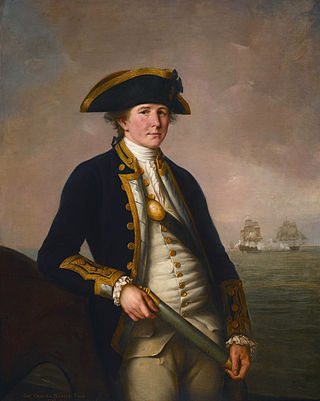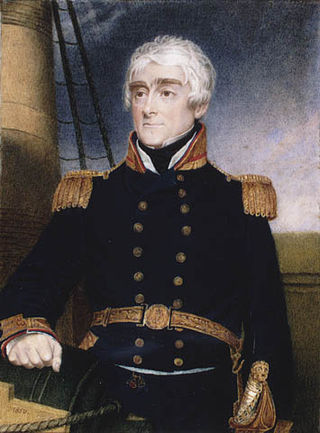
Admiral of the Fleet Edward Russell, 1st Earl of Orford, PC was a Royal Navy officer and politician. After serving as a junior officer at the Battle of Solebay during the Third Anglo-Dutch War, he served as a captain in the Mediterranean Sea in operations against the Barbary pirates.

Admiral Sir Charles Saunders was a Royal Navy officer. He commanded the fourth-rate HMS Gloucester and led her in action at the Second Battle of Cape Finisterre in October 1747 during the War of the Austrian Succession. After serving as Commander-in-Chief, Mediterranean Fleet, he was appointed Commander-in-Chief, English Channel in charge of the Western Squadron between October 1758 and May 1759). He took command of the fleet tasked with carrying James Wolfe to Quebec in January 1759 and consolidated the dead general's victory after the Battle of the Plains of Abraham in September 1759 by devoting great energy to keeping the British Army, now under the command of Colonel George Townshend, well supplied during the Seven Years' War. He later became Senior Naval Lord and then First Lord of the Admiralty.

Admiral of the Fleet James Gambier, 1st Baron Gambier, was a Royal Navy officer. After seeing action at the capture of Charleston during the American Revolutionary War, he saw action again, as captain of the third-rate HMS Defence, at the battle of the Glorious First of June in 1794, during the French Revolutionary Wars, gaining the distinction of commanding the first ship to break through the enemy line.

Admiral Sir James Whitley Deans Dundas GCB was a Royal Navy officer. He took part in the Napoleonic Wars, first as a junior officer when he took part in the Anglo-Russian invasion of Holland in Autumn 1799 and later as a commander when he was in action at Copenhagen Dockyard shortly after the capture of that City in August 1807. He also served as Whig Member of Parliament for Greenwich and then for Devizes and became First Naval Lord in the First Russell ministry in July 1847 and in that role his service was dominated by the needs of Whig party. He was appointed Commander-in-Chief in the Mediterranean in 1852 and led all naval operations in the Black Sea including the bombardment of Sevastopol in October 1854 during the Crimean War.
Admiral of the Fleet Sir William Hall Gage was Second Sea Lord in the British Navy. He took part in the Battle of Cape St Vincent and the Siege of French-held Malta during the French Revolutionary Wars. He also saw action at the attack on the French ship Romulus during the closing stages of the Napoleonic Wars.

Admiral of the Fleet Matthew Aylmer, 1st Baron Aylmer, of Covent Garden, Westminster, and Westcliffe, near Dover, was an Anglo-Irish Royal Navy officer and Whig politician who sat in the English and British House of Commons between 1695 and 1720.

The Commander-in-Chief, The Nore, was an operational commander of the Royal Navy. His subordinate units, establishments, and staff were sometimes informally known as the Nore Station or Nore Command. The Nore is a sandbank at the mouth of the Thames Estuary and River Medway.

Admiral of the Fleet Sir Charles Morice Pole, 1st Baronet GCB was a Royal Navy officer, colonial governor and banker. As a junior officer he saw action at the siege of Pondicherry in India during the American Revolutionary War. After taking command of the fifth-rate HMS Success he captured and then destroyed the Spanish frigate Santa Catalina in the Strait of Gibraltar in the action of 16 March 1782 later in that War.

Admiral of the Fleet Sir William Parker, 1st Baronet, GCB, was a Royal Navy officer. As a captain's servant he took part in the Battle of The Glorious First of June in June 1794 during the French Revolutionary Wars and, as a captain, he participated in the capture of the French ships Marengo and Belle Poule at the action of 13 March 1806 during the Napoleonic Wars. He was detached on an independent command on the Tagus in September 1831 with a mission to protect British interests during the Portuguese Civil War. As Commander-in-chief of the East Indies and China Station, he provided naval support at various actions between 1841 and 1842 during the First Opium War. Appointed Commander-in-Chief, Mediterranean Fleet in February 1845, he was briefly First Naval Lord in the First Russell ministry from 13 July 1846 to 24 July 1846 but gave up the role due to ill health before returning to his command with the Mediterranean Fleet.

Admiral of the Fleet Sir Rhoderick Robert McGrigor was a senior Royal Navy officer. He fought in the First World War and saw action during the Gallipoli Campaign and then the Battle of Jutland. He also served in the Second World War, taking part in the sinking of the Bismarck in May 1941, carrying out the office of Assistant Chief of the Naval Staff (Weapons) and commanding the 1st Cruiser Squadron during operations off the Norwegian coast and convoys to North Russia. Furthermore, he served as First Sea Lord in the early 1950s and is most remembered as a leading proponent of carrier-based air power.

Admiral of the Fleet Sir Chaloner Ogle KB was a Royal Navy officer and politician. After serving as a junior officer during the Nine Years' War, a ship he was commanding was captured by three French ships off Ostend in July 1706 in an action during the War of the Spanish Succession.
HMS Restoration was a 70-gun third rate of the Kingdom of England built at Harwich Dockyard in 1677/78. After a ten-year stint in Ordinary she was commissioned for the War of the English Succession in 1690. She fought in the Battles of Beachy Head and the Battle of Barfleur. She was rebuilt at Portsmouth in 1699/1702. She was lost on the Goodwin Sands during the Great Storm of November 1703.

Admiral of the Fleet Sir Arthur John Power, was a Royal Navy officer. He took part in the First World War as a gunnery officer and saw action in the Dardanelles campaign. During the inter-war years he commanded the gunnery school at HMS Excellent and then the aircraft carrier HMS Ark Royal. During the Second World War he played a leading role in the planning for the Allied invasion of Sicily and for the Allied invasion of Italy and then commanded the naval forces for the actual landing of V Corps at Taranto in Italy in September 1943. He went on to be Commander-in-Chief of the East Indies Fleet in the closing stages of the war and conducted naval strikes on the Imperial Japanese Army in Borneo and Malaya. After the War he became Second Sea Lord and Chief of Naval Personnel, Commander-in-Chief, Mediterranean Fleet and then Commander-in-Chief, Portsmouth.
HMS Reserve was one of six 40-gun fourth-rate frigates, built for the Commonwealth of England under the 1650 Programme, after the Restoration of the monarchy in 1660 she was incorporated into the navy of the Kingdom of England. She partook in no major Fleet actions during the First Anglo-Dutch War. After the Restoration during the Second Anglo-Dutch War she partook in the Battle of Lowestoft, the Four Days' Battle and the St James Day Battle. She spent the bulk of her service either in the Mediterranean or at Newfoundland. She foundered off Yarmouth in November 1703.

Admiral of the Fleet Sir Houston Stewart, was a Royal Navy officer and briefly a Liberal Party Member of Parliament. After serving as a junior officer in the Napoleonic Wars, Stewart became commanding officer of the third-rate HMS Benbow in the Mediterranean Fleet and took part in the bombardment of Acre during the Egyptian–Ottoman War. He went on to be Captain-Superintendent of Woolwich Dockyard and then Controller-General of the Coastguard.

Admiral of the Fleet Sir Charles Ogle, 2nd Baronet was a Royal Navy officer. As a junior officer, he saw action leading storming parties at the capture of Martinique and at the capture of Guadeloupe during the French Revolutionary Wars. He also took part in the landings in Egypt in the later stages of the French Revolutionary Wars.
Sir Edward Whitaker was an officer of the Royal Navy. He served during the War of the Spanish Succession and is known for his role in the Capture of Gibraltar and the Battle of Málaga in 1704.
Vice Admiral James Littleton (1668–1723) was a Royal Navy officer who served as Commander-in-Chief of the Jamaica Station.
Commodore Thomas Warren was a Royal Navy officer who became Commander-in-Chief, Portsmouth.
Rear Admiral William Caldwell was a Royal Navy officer who briefly served as Commander-in-Chief, The Thames from 12 November 1717 to 1 December 1717.












